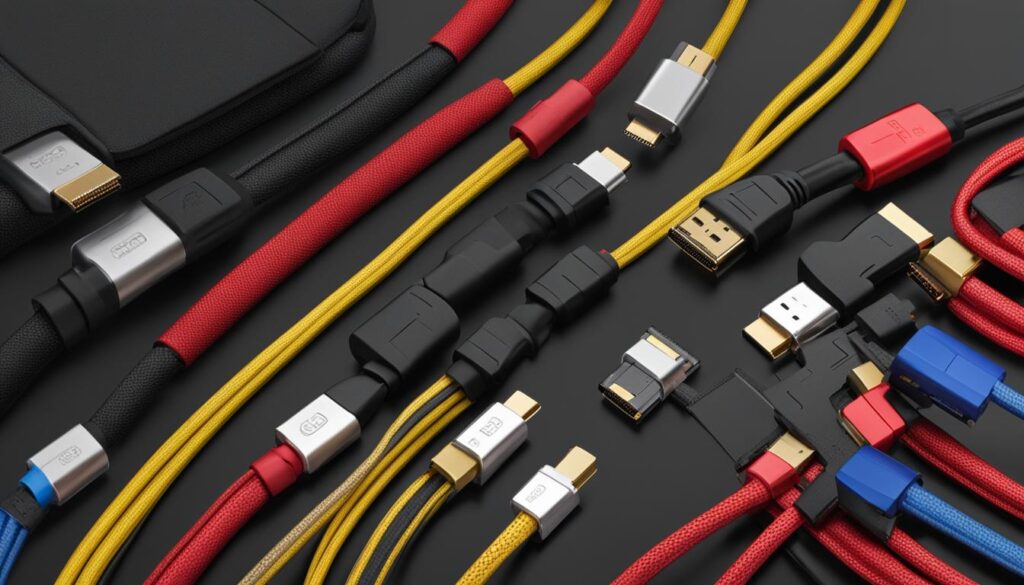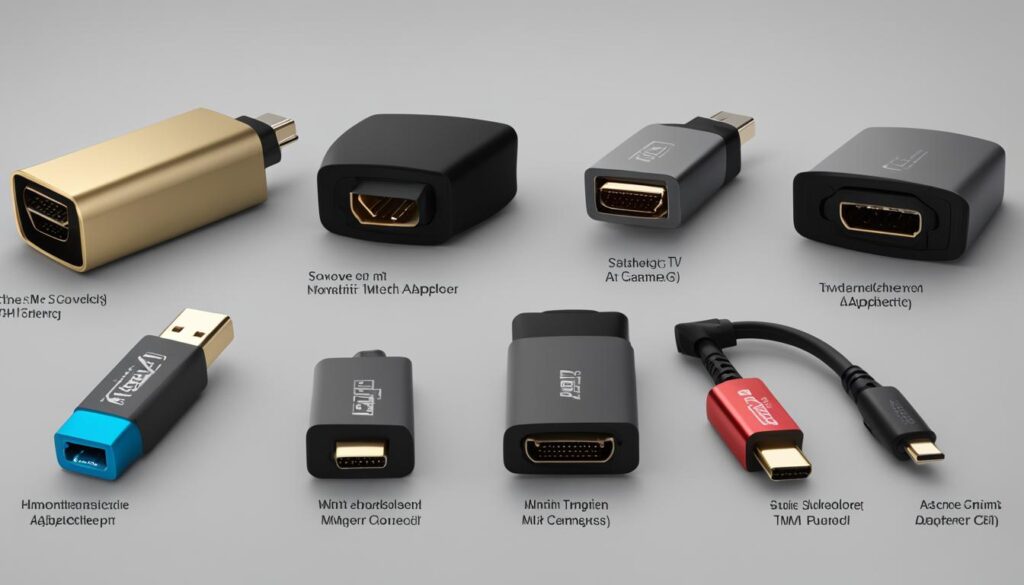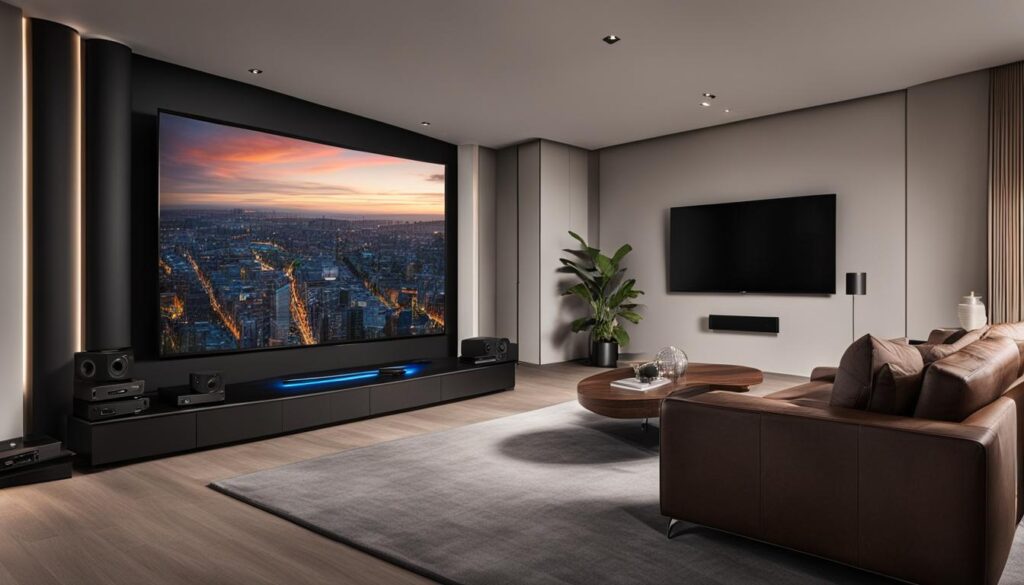Ever wondered how the crisp images and vibrant sounds from your favorite game or movie are seamlessly transmitted from your device to your screen? The hero behind the scenes is often the humble HDMI to HDMI cable. This nifty piece of technology is the cornerstone of modern multimedia setups, acting as a bridge that carries high-definition video and audio transmission from HDMI-enabled devices to your displays.
The HDMI interface was a game-changer when it first emerged, offering a high-quality digital signal that could handle both the video and sound without the mess of multiple cables. Whether you’re assembling a home theater system or simply want to enjoy content from your gaming console, the HDMI to HDMI cable is pivotal for a fuss-free entertainment experience.
With billions of devices equipped with HDMI, understanding what this cable is used for is fundamental for anyone looking to optimize their audio-visual experience. Not just any cable will do—choosing the right HDMI cable can mean the difference between a good viewing experience and a great one.
Key Takeaways
- HDMI to HDMI cables facilitate the transfer of both video and audio digital signals over a single cable.
- They are ubiquitous in multimedia setups, essential for connecting devices like TVs, computers, and gaming consoles.
- The advent of the HDMI interface replaced the need for separate audio and video cables, simplifying the configuration process.
- Understanding the specific use and capabilities of your HDMI-enabled devices is crucial for selecting an appropriate HDMI cable.
- Due to HDMI’s widespread adoption, it’s important to invest in a cable that matches the resolution and speed required by your hardware.
Introduction to HDMI Technology
Welcome to the world of HDMI (High-Definition Multimedia Interface), a ubiquitous standard in the realm of digital entertainment and media. HDMI has transformed the way you experience audiovisual content, leaving behind the jumble of audio and video cables for a singular, streamlined solution. At its core, HDMI provides a conduit for high-resolution video and digital audio, making it the preferred connectivity standard over others like DVI (Digital Visual Interface).
Imagine yourself setting up a home theater with cinema-quality sound and high-definition imagery, or connecting a gaming console to your TV to unwind after a long day—HDMI makes these experiences possible with ease. The interface is engineered to transmit uncompressed video signals and compressed or uncompressed digital audio signals from an HDMI-compliant source to a compatible computer monitor, video projector, digital television, or digital audio device.
But HDMI isn’t just about blazing-fast video and crystal-clear audio; it also simplifies device control with the transmission of device commands. This feature is a gem, enabling you to handle multiple connected devices with a single remote control—for example, adjusting your soundbar volume while it’s connected to your Smart TV.
HDMI connectors adapt to your diverse array of multimedia devices by coming in three main sizes:
- Standard HDMI (Type A)
- Mini HDMI (Type C)
- Micro HDMI (Type D)
While these connectors pave the way for various devices to communicate, HDMI cables are categorized according to their specification and capabilities such as video resolution and bandwidth. These are the main types of HDMI cables you might encounter:
| Cable Type | Video Resolution | Bandwidth |
|---|---|---|
| Standard HDMI | Up to 1080i or 720p | Up to 5 Gbps |
| High Speed HDMI | Up to 4K@30Hz | Up to 10 Gbps |
| Premium High Speed HDMI | 4K@60Hz, HDR | Up to 18 Gbps |
| Ultra High Speed HDMI | 8K@60Hz, 4K@120Hz | Up to 48 Gbps |
Each HDMI cable tier supports a vast landscape of capabilities—from enveloping your senses in high-resolution video to immersing you in theater-quality soundscapes. When considering an upgrade to your system or purchasing new components, look for the matching HDMI cable type that will fit your specific requirements for bandwidth and resolution. Doing so will ensure you obtain the optimum performance from your setup.
With the introduction of HDMI, setting up your media devices is now more intuitive and results in a more polished, high-fidelity audiovisual experience. The next time you plug in your game console or smart TV, take a moment to appreciate the advanced technology behind that small, yet mighty HDMI cable powering your entertainment.
The Evolution of HDMI Standards
As you delve into the world of high-quality digital transmission, the evolution of HDMI standards from HDMI 1.0 to the remarkable HDMI 2.1, is a journey through technology’s relentless pursuit of excellence. Witnessing the growing appetite for High Definition (HD) and Ultra High Definition (UHD), the HDMI standard has advanced, keeping pace with the skyrocketing demands for higher bandwidth and more refined features. Buckle up as we take a ride through the HDMI timeline, exploring how this digital superhero has continuously reshaped the multimedia landscape.
HDMI 1.0 to HDMI 2.1: A Timeline
| HDMI Version | Release Year | Main Enhancements |
|---|---|---|
| HDMI 1.0 | 2002 | Initial release, up to 1080p at 60 fps, 8-channel audio. |
| HDMI 1.1/1.2 | 2004/2005 | DVD Audio, YCbCr color space, Type A connector. |
| HDMI 1.3 | 2006 | Increased bandwidth, deep color, HDMI Mini connector. |
| HDMI 1.4 | 2009 | HDMI Ethernet Channel, Audio Return Channel, HDMI Micro connector. |
| HDMI 2.0 | 2013 | 18 Gb/s bandwidth, 4K at 60 Hz, 21:9 aspect ratio. |
| HDMI 2.1 | 2017 | 48 Gb/s bandwidth, resolutions up to 10K, eARC, DSC 1.2a. |

Impact of High Definition and Ultra High Definition on HDMI
The ubiquity of 4K HDMI and the anticipation of 8K HDMI standards have been significantly influenced by the advancements in HD and UHD technologies. With these innovations, HDMI features have expanded to encompass HDMI data rate improvements and greater bandwidth capacities to ensure the signal integrity of high-fidelity video and audio streams. The HDMI timeline has clearly demonstrated the standard’s adaptability, accommodating resolutions that once seemed a feat of the distant future.
- Increased bandwidth from 4.95 Gb/s in HDMI 1.0 to a staggering 48 Gb/s in HDMI 2.1.
- Support for higher video resolutions, including 4K and even 8K, ensuring HDMI is synonymous with cutting-edge display technologies.
- Introduction of HDMI Ethernet Channel and new forms of chroma subsampling for richer media experiences.
Display Stream Compression and Advanced Features
Pushing the boundaries even further, the implementation of Display Stream Compression (DSC) technology has made HDMI more adept at handling high frame rates and resolutions while preserving the visual integrity of the stream. This advancement, combined with the likes of Transition-Minimized Differential Signaling (TMDS), High-Bandwidth Digital Content Protection (HDCP), and HDMI authentication, continue to safeguard the integrity of digital content as it journeys from source to display.
- Enabling visually lossless video compression to support Ultra High Definition (UHD) display technologies like 4K and 8K.
- Advanced HDMI features ensuring compatibility and enhanced viewing experiences for various video resolutions and refresh rates.
- Strengthening user convenience and device interoperability through reliable HDMI authentication protocols.
The trailblazing HDMI standards have not only revolutionized the media industry’s approach to digital transmission but have also laid a solid foundation for future innovations. As you move forth in the digital age, you can trust that HDMI will continueto evolve, further enhancing your audiovisual journey through quality, convenience, and immersive display capabilities.
Different Types of HDMI Cables and Their Uses
As you delve into the realm of home entertainment or gaming, the significance of HDMI cables can’t be overstated. These conduits of digital data are vital for a stellar audiovisual experience. But not all HDMI cables are created equal; there are various HDMI cable types each designed to meet different needs. Whether your setup calls for a standard HDMI or an ultra high speed HDMI, knowing the capabilities of each type can help enhance your multimedia engagement.
HDMI Ethernet Channel brings an additional facet to the already dynamic HDMI cable. It allows devices to share internet connectivity without the need for separate networking cables. It’s crucial to select a cable that matches the resolution and refresh rate your devices require, without overlooking the necessary bandwidth to streamline the data flow.

- If you’re connecting a DVD player to an HDTV, a standard HDMI cable suffices, supporting up to 1080i or 720p.
- For gaming enthusiasts or 4K video content, high speed HDMI cables are recommended as they can handle 1080p or 4K resolutions at 30Hz.
- Premium high speed HDMI cables are tailor-made for 4K or UHD displays, elevating your viewing experience with 4K60 capabilities, HDR, and broader color ranges.
- The advent of 8K showcases the need for ultra high speed HDMI cables, boasting bandwidths up to 48Gbps and supporting the pinnacle of resolutions and refresh rates.
| Cable Type | Resolution Support | Refresh Rate | Bandwidth |
|---|---|---|---|
| Standard HDMI | Up to 1080i or 720p | 30Hz | Up to 4.95 Gbps |
| High Speed HDMI | 1080p or 4K@30Hz | 30Hz | Up to 10.2 Gbps |
| Premium High Speed HDMI | 4K@60Hz, HDR | 60Hz | Up to 18 Gbps |
| Ultra High Speed HDMI | 8K@60Hz, 4K@120Hz | 60-120Hz | Up to 48 Gbps |
In addition to selecting the proper type, HDMI cables catering to automotive applications include enhanced durability features, like reinforced shielding to withstand the demands of a mobile environment. No matter the application, from a desktop setup streaming the latest viral videos to a dedicated home theater system enjoying blockbuster hits, there’s an HDMI cable that’s cut out for the job—ensuring a seamless and rich multimedia experience.
HDMI Connectors: Standard, Mini, and Micro Explained
When it comes to setting up your devices for the optimal audiovisual experience, understanding the different types of HDMI connectors is fundamental. The right connector not only ensures a perfect fit but also maximizes the functionality of your HDMI-enabled devices. Let’s dive into the details of standard HDMI, mini HDMI, and micro HDMI connectors, which facilitate seamless digital media enjoyment.
- Standard HDMI – This is the standard HDMI (Type A) connector you’re likely most familiar with. It’s the default HDMI connector for a wide range of devices such as TVs, gaming consoles, and home theater systems. Designed to support all HDMI bandwidth modes, it’s also electrically compatible with single-link DVI-D, making it incredibly versatile.
- Mini HDMI – Mini HDMI (Type C) connectors are a compact solution designed particularly for portable devices. Despite their smaller size, they maintain the same 19-pin configuration as standard HDMI, with different assignments to accommodate the portable nature of the devices they serve.
- Micro HDMI – With the shrinking size of portable technology, micro HDMI (Type D) connectors are even smaller than mini HDMI. Commonly found on smartphones and certain cameras, they continue the 19-pin tradition but in a form factor suitable for the most compact of devices.
- Automotive HDMI – HDMI (Type E) connectors, with their robust locking tabs and protective shells, are engineered to withstand conditions in vehicle settings where other connectors might fail due to vibrations.
Adapting to Various Devices with HDMI Adapters
Given the variety of HDMI connection types, you may often find yourself needing an intermediary to connect incompatible ports. Enter HDMI adapters, the ultimate problem-solvers in device adaptation. These adapters play a critical role in signal conversion, allowing you to link devices regardless of the HDMI port types available.
For instance, if your laptop lacks a standard HDMI port but features a USB-C connection, there’s an HDMI adapter for that. USB-C in Alt Mode can take advantage of HDMI adapter types to support HDMI 1.4b features and maintain device compatibility. This versatility ensures you can enjoy the full benefits of HDMI technology, from high-resolution video to multi-channel audio, across all your devices. Check out the list below of common adapter solutions and their compatibility.
| HDMI Adapter Type | Input Port | Output Port | Supported HDMI Features |
|---|---|---|---|
| Standard HDMI to Mini HDMI | Standard HDMI (Type A) | Mini HDMI (Type C) | Video and audio up to HDMI 1.4 |
| Standard HDMI to Micro HDMI | Standard HDMI (Type A) | Micro HDMI (Type D) | Uncompressed audio/video signal |
| USB-C to HDMI Adapter | USB-C (Alt Mode) | Standard HDMI (Type A) | 4K resolution support |
| Mini HDMI to Micro HDMI | Mini HDMI (Type C) | Micro HDMI (Type D) | Compact device connectivity |
HDMI adapters prove invaluable in scenarios where you have multiple devices with different connector specifications. Utilizing these adapter cables enhances HDMI compatibility across the board, ensuring that regardless of the evolving landscape of device ports, your HDMI connection needs are always met. So whether you’re presenting from a tablet, sharing content from your smartphone, or enjoying high-definition videos, HDMI adapters ensure your devices work together harmoniously.

The Importance of HDMI in Home Theater and Gaming Setups
In the pursuit of the ultimate audiovisual experience, the importance of HDMI technology cannot be overstated. It plays a central role in both home theater and gaming setups, bridging the gap between the digital media you enjoy and the electronic devices that deliver it. As the entertainment industry continues to advance, the reliance on HDMI for high-definition transmission is more crucial than ever.
Whether you’re a cinephile seeking a cinematic experience in the comfort of your living room or a gamer craving immersive gameplay, HDMI is the key to unlocking a world of dazzling visuals and crisp audio. Thanks to HDMI, setting up a home theater or gaming console like Xbox or PlayStation is a breeze, allowing for the swift and efficient transfer of high-definition content.
HDMI cables for gaming are particularly significant, providing the necessary high-speed connection that can accommodate the rapid frame rates and complex graphics of modern games. Gaming setups rely on HDMI’s ability to support not only stunning visuals but also low latency, which is paramount for a competitive edge.
For movie buffs, home theater systems benefit immensely from HDMI’s ability to handle digital surround sound, creating an enveloping atmosphere akin to a movie theater. HDMI facilitates a clutter-free, streamlined setup, connecting various devices such as HDTVs, gaming consoles, and streaming devices like Apple TV.
The integration of HDMI has had a significant impact on the realm of electronic devices, moving beyond mere audio and video transmission. Enhanced remote control functions, internet connectivity, and compatibility with various devices have all been made possible through the continued evolution of HDMI standards.
Beneath its simple exterior, an HDMI cable is an engineering marvel that supports an incredible array of functions. Let’s take a closer look at what an HDMI cable offers your home entertainment or gaming setup:
| Feature | Description | Benefit to You |
|---|---|---|
| High-Definition Video | Transmits video up to 8K resolution | Enjoy crystal-clear imagery and lifelike visuals |
| Audio Transmission | Carries multi-channel audio including Dolby Atmos | Immersive sound quality that matches the high-definition video |
| Device Control | Allows control of connected devices via a single remote | Streamlines your entertainment system for ease of use |
| Internet Connectivity | Supports devices with HDMI Ethernet Channel (HEC) | Connects your devices to the internet without extra cabling |

As the connecting thread in a web of digital media, HDMI is the unsung hero in the evolution of home entertainment. It’s not just about the image on the screen or the sound through the speakers; it’s about the synthesis of complex data into a seamless, user-friendly form. HDMI stands at the forefront of this convergence, continuously adapting and evolving to meet the ever-growing demands of high-resolution digital media.
The convergence of HDMI technology has not only simplified the complexities of modern audiovisual needs but has also crafted an unrivaled multimedia experience. From HDTVs to surround sound systems and gaming consoles, HDMI is the undeniable backbone of a quality digital entertainment setup.
Choosing the Right HDMI Cable for Your Needs
In this golden age of visual media, the difference between an average and an exceptional viewing experience often lies in the tiny details, such as choosing the right HDMI cable for your system. As you embark on this selection journey, here are some key HDMI cable buying tips to guide you towards making an informed decision. First and foremost, consider the capabilities of your devices, especially if they support 4K UHD, HDR, or are compatible with HDMI 2.1a for that high-definition, buttery-smooth 4K60 playback.
When it comes to cable length, the rule of thumb is simple: long enough to connect your devices comfortably but not so long that it leads to potential signal degradation. And let’s not forget the speed; while High Speed HDMI cables adequately cater to many modern devices, serious gamers and cinephiles might want to up the ante with Premium High Speed or Ultra High Speed options to fully harness the power of their high-performance electronics. Remember, an impeccable setup is complemented by strategically selected digital media accessories, such as reliable HDMI switching solutions that streamline your connections and enhance your media experience.
Lastly, be savvy with your finances—high price does not always equate to high quality. Seek out trusted brands, and comparison shop to ensure you’re investing in a cable that not only fits your budget but also lives up to your digital media’s potential. By following these guidelines, you can harmonize your setup’s demands with your HDMI cable choice, resulting in a rich, uninterrupted cascade of audiovisual splendor that brings your content to life.
